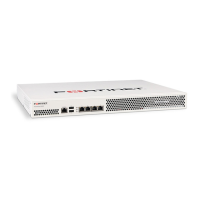Fortinet Technologies Inc. Page 43 FortiVoice 200D/200D-T v2.0 MR1 CLI Reference
extension user
Use this sub-command to configure IP extensions.
An IP extension is an IP phone connected through a network to a system. An internal IP
extension is a phone connected on the same LAN as the system. An external IP extension is a
phone connected outside the LAN.
Syntax
config extension user
edit <name>
set department <name>
set fax {enable | disable}
set fxs-port <port>
set handset-id <integer>
set mac-addr <xx:xx:xx:xx:xx:xx>
set number <string>
set password <string>
set profile-phone <name>
set sip-setting <name>
set sound-language <name>
set status {enable | disable}
set type {sip | analog}
set user-privilege <name>
end
Variable Description Default
<name> Enter the name/ID for the extension.
department <name> Enter the department that the extension belongs to.
fax {enable | disable} Enable to activate facsimile function for the extension.
200D-T model only.
disable
fxs-port <port> Enter the analog port number.
200D-T model only.
fxs1
handset-id <integer> If your phone type is FortiFone-850i/860i, you can enter
the handset ID range (1-8) because these models
support multiple handset and each handset is assigned
an extension number.
mac-addr <xx:xx:xx:xx:
xx:xx>
Enter the MAC address of the SIP phone using the
extension number.
00:00:00:
00:00:00
number <string> Enter the extension number following the extension
number pattern.
See the pattern-matching syntax and pattern-matching
examples in “pbx number-management” on page 57.
password <string> Enter the password used for configuring your SIP phone
from the phone or the Web. You need the phone's IP to
access it from the Web.
voice#321

